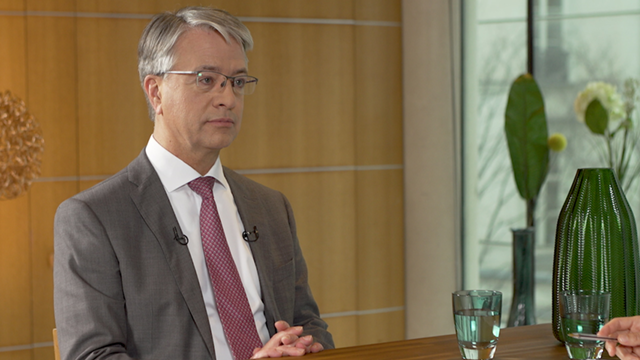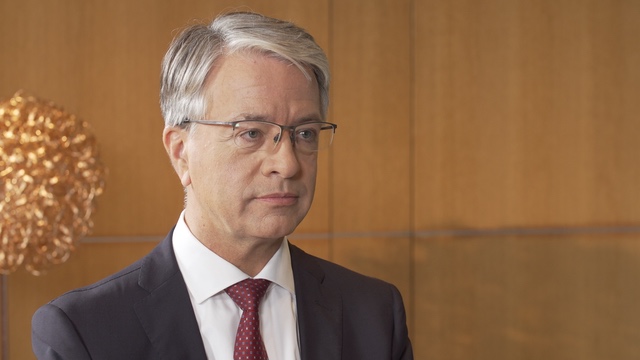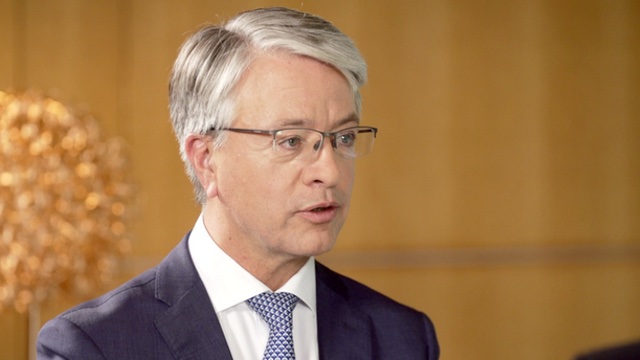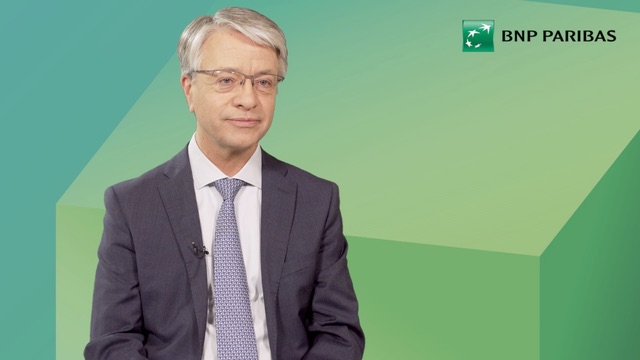EuroBusiness Media (EBM): BNP Paribas, one of Europe’s leading banks, reports results for the full year 2013. Jean-Laurent Bonnafé, welcome. You are the CEO of BNP Paribas. What are your comments on the Group’s performance for the full year and in the fourth quarter?
Jean-Laurent Bonnafé: In 2013 BNP Paribas’ revenues proved quite resilient considering the challenging European economic backdrop. In fact, revenues of the operating divisions were just 1.6% lower at constant scope and exchange rates mainly on the back of lower client demand in Fixed Income.
In terms of costs, we’ve continued to keep operating expenses under control. Costs of the operating divisions were 0.5% lower at year-end on the same like-for-like basis.
Cost of risk was moderate over the year. At Group level it stood at 63 basis points as a percentage of customer loans.
2013 results were impacted by two significant one-off items: the first related to the transformation costs booked for our cost saving plan Simple & Efficient which amounted to 661 million euros. The second was a provision related to the review of certain US dollar payments involving parties subject to US economic sanctions for 798 million euros. Despite this, the Group still managed to generate 4.8 billion euros of net income. And if we exclude the exceptional items, the yearly net result stood at 6 billion euros.
In the fourth quarter the operating divisions showed a resilient performance with revenues up 0.4%. However, the impact of transformation costs for the quarter and of the extraordinary provision I referred to earlier, weighed on the net result. Excluding exceptional items, the net result for the fourth quarter amounted to over 1.3 billion euros.
BNP Paribas also confirmed very strong solvency and liquidity during the year. In fact at year-end the Group’s fully loaded Common Equity Tier 1 ratio under Basel 3 stood at 10.3%. Similarly the immediately available liquidity reserves were further strengthened to a massive 247 billion euros.
BNP Paribas also continued to boost its deposit base as confirmed by Retail Banking deposits which increased by over 4% compared to the previous year.
For 2013 we are proposing a dividend per share of 1.50 euros, in line with the previous year. This implies a pay-out ratio in 2013 of just over 40%.
To conclude, BNP Paribas continued to create value for its shareholders in 2013. In fact our book value per share increased to 63.6 euros while the tangible book value per share also improved to 53.5 euros
EBM: On cost of risk, could you provide some additional insight on the evolution of your different businesses in 2013?
Jean-Laurent Bonnafé: As I mentioned before, the Group’s cost of risk was moderate in 2013, marking a 2.9% increase over the year. This was almost entirely due to the high level in Italy deriving from the prolonged recession in the country.
Looking beyond this, practically all other businesses and geographies showed stable or improving cost of risk.
EBM: How would you rate the performance of your Domestic Markets given the lacklustre European backdrop in 2013? Were you successful in withstanding the low interest rate environment in these retail markets?
Jean-Laurent Bonnafé: Throughout 2013, Domestic Markets deposits have maintained a good growth trend in all the networks as well as at Cortal Consors in Germany. On the other hand, the slowdown in credit demand has continued.
Our unique “One Bank for Corporates” set up continued to generate new clients. Over the 3 years since launch, Domestic Markets clients have opened some 4,000 new accounts in our global network. And in cash management the latest Greenwich survey confirms our position as European number 1.
Our new fully mobile bank “Hello bank!” was successfully launched in Germany, Belgium, France and Italy. At year-end 2013 it had already been chosen by over 175,000 clients in the four countries and had gathered deposits for 1.8 billion euros. I would call this a promising start!
In a context of subdued economic activity and low interest rates, Domestic Markets revenues were slightly higher reaching close to 16 billion euros for the year. This was helped by the pick-up in financial fees and by the good contribution of Arval, which offset lower loan stocks. Hence, I think you can clearly see that, thanks to an excellent commercial drive, Domestic Markets proved quite resistant.
At constant scope, operating costs marked a 1% contraction net of development costs for the launch of Hello bank!. This in turn led to an improvement of the cost/income ratio in our three main networks.
Gross operating income improved by 2.4% net of the Hello bank! costs while pre-tax income reached 3.7 billion euros for the full year.
In conclusion, I would say that Domestic Markets performed well given the sluggish environment on the back of improving operating efficiency.
EBM: Looking beyond Europe, what can you say on your international retail banking performance? Have you been impacted by the recent currency volatility in some emerging markets?
Jean-Laurent Bonnafé: Well, starting with our Europe-Med division, one notable event in 2013 was the signing of the agreement to buy BGZ in Poland. Once completed, this transaction will position BNP Paribas as the seventh banking player in the country, giving us the critical size we were lacking.
Europe-Med confirmed good commercial and marketing drive throughout 2013. Deposits increased over 12% with good growth in most countries. Loans progressed by 7.4%. And we continued to develop our cash management offer in the region.
The second part of the year was marked as you mentioned by significant currency fluctuations, notably that of the Turkish Lira. This did not really impact TEB’s local activity and on a Group scale the impact on net results was not significant. Considering P&L changes at constant scope, Europe-Med revenues were up nearly 7% despite the impact of new regulations in Turkey and Algeria. Costs increased essentially due to continuing investments in the commercial set-up, in particular in Turkey. This was partially offset by ongoing actions to improve operating efficiency in Poland and the Ukraine.
Overall, thanks to a lower cost of risk, an improving contribution from Bank of Nanjing and the sale of our Egyptian subsidiary in Q2, Europe-Med closed the year with a pre-tax income of 465 million euros, showing a very strong evolution over the previous year.
To complete the overview of our international retail let’s now move to the US. BancWest confirmed a dynamic business activity. Deposits increased by close to 4% while loans were up 3.6% with a significant performance in terms of corporate loans.
We continued to boost the assets under management in our Private Banking which exceeded 7 billion dollars at year-end 2013. Moreover our Mobile Banking offer has had a good success with our clients and in just 1 year we already had over 220 thousand monthly users.
Revenues were softer while operating costs increased as a result of the investments to strengthen the corporate and Private Banking set ups. Thanks to a low cost of risk, pre-tax income was almost stable at 770 million euros, confirming BancWest’s strong profitability.
EBM: You are a leading player in consumer finance across Europe and your strategy is to develop joint ventures and commercial agreements. How effective has this strategy proven in sustaining your Personal Finance performance in 2013?
Jean-Laurent Bonnafé: Personal Finance has remained very active in 2013 as it pursues its strategy of diversifying its global sources of income. In France, for example, the transformation of the business model has continued with the signing of partnership agreements, like the one with the supermarket chain CORA, together with an increased focus on savings collection.
In parallel, Personal Finance has continued to develop its international axes for growth. The successful JV agreement with Sberbank in Russia and the signing of partnerships in China with Bank of Nanjing and the car manufacturer Geely represent promising channels for future growth.
This dynamic development was also reflected in the full year results. In fact consumer finance revenues were nearly 1% higher while mortgage revenues continued to be hampered by the ongoing reduction of stocks as part of the adaptation plan.
Significantly lower costs led to a further improvement of the cost/income ratio to a very competitive 46%.
Given the stability of the cost of risk, pre-tax income increased to 1.2 billion euros, up 4.5% versus the previous year. I would say that this is the best proof of the effectiveness of our strategy in this business.
EBM: In Investment Solutions, you have been steadily growing your business in areas such as insurance and custodian activity. What is your update on the different business areas for 2013?
Jean-Laurent Bonnafé: Investment Solutions has continued to develop its activity throughout 2013. Total assets under management were almost stable at 885 billion euros, showing a small pick-up in Q4. In a nutshell the strong performance effect deriving from higher stock markets was offset by a negative foreign exchange effect coupled with net outflows. These were essentially due to continued outflows in money market funds while businesses like Wealth Management and Insurance showed healthy inflows especially in Asia and Italy.
Investment Solutions has continued to pursue its international development. This was the case in Germany where Securities Services and Real Estate made local acquisitions. In Asia our Insurance business has recently signed two new partnerships with Bank of Beijing in China and with Saïgon Commercial Bank in Vietnam.
In terms of revenues this translated into a 3.8% increase at constant scope over the year. Insurance was the main contributor to revenue growth as both savings and protection grew especially in Asia and Latin America. Wealth & Asset Management revenue growth was driven by Wealth Management and Real Estate while Securities Services revenues were slightly up.
Operating costs increased at a lesser pace than revenues meaning that the cost/income ratio of Investment Solutions improved by one full point in 2013.
Overall, pre-tax income topped 2.1 billion, marking a 4.5% improvement at constant scope and exchange rates.
EBM: In capital markets, rising stock markets sustained the equity business while fixed income activity was somewhat downbeat. How did BNP Paribas fare in this context? In the financing business, how have you progressed in terms of adapting your business model?
Jean-Laurent Bonnafé: The broad trends you have depicted for Capital Markets were essentially true also for BNP Paribas. Revenues were affected by reduced client activity due to difficult market conditions which were mostly related to uncertainty on the Fed’s tapering. In addition, our VaR was kept at a very low level throughout the year.
Our Fixed Income was penalized by low client demand in interest rates and credit activities while forex performed better. In any case it must be noted that 2012 was a high comparison base as the announcements by the ECB of the LTRO and then the OMT had buoyed the markets.
Despite this, in 2013 we managed to strengthen our leading positions in bond issuance. In fact we climbed to the number 1 spot for “all bonds in Euros” and confirmed our number 8 ranking for “all international bonds”.
Our Equity & Advisory performed well, driven by a rise in transaction volumes on equity markets, in particular in Europe and in Asia. We also saw a significant increase in clients’ demand for structured products. Equity-linked business was also quite good and we ranked number 3 for issues in Europe.
In the financing business, which is our Corporate Banking, we’re continuing to roll-out the new business model. Revenues were still affected by the reduction of outstanding loans resulting from the 2012 adaptation plan. However, outstandings seem to be bottoming out and Q4 actually showed a slight increase compared to the previous quarter. Fees increased by almost 10% and Corporate Banking has continued to progressively develop the “Originate to Distribute” approach with its corporate clients.
In syndicated loans we confirmed our number 1 position in the EMEA region with strong rankings in all the main sectors.
In terms of geographies, demand remained sluggish in Europe while it progressively picked up in the Americas and continued to expand in Asia-Pacific.
On the funding side, deposits reached nearly 59 billion euros, marking an 11.7% increase on the previous year thanks to deposit gathering and development of our cash management offer. In cash management we have gained some significant new mandates in 2013 which helped strengthen our global ranking with corporates which climbed to number 4.
EBM: Your bank has been one of the swiftest in adapting to the new regulatory context and, to use your words, you now boast a “rock solid balance sheet”. Could you update us on the evolution on this front?
Jean-Laurent Bonnafé: As you mention, we have a rock-solid balance sheet and we can say that BNP Paribas is today prudentially ready.
In terms of Solvency, as I said earlier, our fully loaded Common Equity Tier 1 ratio under Basel 3 exceeds 10%. It actually stands at 10.3% to be precise, well above the minimum requirement.
Our Basel 3 leverage ratio stood at 3.7% at year-end 2013, well ahead of the 3% minimum threshold. I remind you that this ratio shall be applicable for European banks from 2018. The Basel committee has proposed certain amendments to the calculation of the ratio which are under discussion. The potential impact of these proposed changes for BNP Paribas is not material.
EBM: You have disclosed your new Business Plan today and you will be hosting an Investor Day next month to provide additional details. What have you identified as the main levers for growth? How confident are you of improving the Group’s return on equity?
Jean-Laurent Bonnafé: The new Business Plan confirms our choice of a universal banking model which revolves around our three main businesses: Retail Banking, CIB and Investment Solutions. It’s a client-driven business model which is well diversified in terms of risks and envisages significant cross selling between the various businesses. And, most importantly, it’s a business model with a proven track record in the case of BNP Paribas.
In the new environment this business model represents a real competitive advantage for the Group. In fact, the Group’s well established presence in retail banking in Europe is complemented by:
1) our critical size in market activities to accompany disintermediation from credit in Europe due to new regulations,
2) business lines within Investment Solutions which gather savings and generate liquidity, and
3) a growing global presence in fast growing areas such as Asia.
The new Plan aims to accompany our clients in a changing world. It targets a level of return on equity of at least 10% in 2016 which equates to a return on tangible equity of at least 12%. This in turn implies an average double digit growth of earnings per share over the period 2014 to 2016.
In order to achieve this, the Group has identified five strategic priorities:
1) The first is to Enhance client focus and service
In the case of Individuals, the aim is to continue to develop digital innovations, to adapt the branch networks, to deepen the client relationship and to continue the strong growth of our Private Banking.
For Corporates, the Group will leverage its European and global set up and its leadership position in cash management in Europe, and will continue the development of Originate to Distribute.
And for Institutionals, we want to implement a more integrated approach with a closer cooperation of market activities, Securities Services and Investment Partners in order to develop new client solutions and share operational platforms
2) The second strategic priority is to Simplify our organization and processes
This is the part “Simple” of our Simple & Efficient plan. It aims to clarify roles and responsibilities in order to speed up decision making processes. Overall, over 420 initiatives are being launched in this field.
3) The third is to Further enhance our operational efficiency
This is the part “Efficient” of our Simple & Efficient program. Our plan to improve operating efficiency has got off to a rapid start with about 800 million of recurrent cost savings booked in 2013 with transformation costs of 660 million. The plan has thus been extended to 2016 with a new increased target of 2.8 billion of recurrent cost savings by that date while transformation costs will total 2 billion over the period 2013 to 2015.
4) The fourth priority is to Adapt certain businesses to the new economic and regulatory environment
Here we are talking mainly of three specific businesses:
1) BNL who will continue its adaptation of the business model to the economic context;
2) Capital Markets with the objective of adapting to the new regulatory environment while improving operating efficiency; and
3) Investment Partners whose plan has already been presented in 2013 and which targets a re-launch of its asset inflows.
5) The fifth and last strategic priority is to Implement specific development initiatives
These will include geographic plans in order to coordinate and accelerate the development of the businesses. I’m referring in particular to:
1) Asia-Pacific which represents a growth area for the Group, and where the development plan has got off to a promising start,
2) CIB-North America where we aim to consolidate our presence in a unique market,
3) Germany which is a target market for our growth in Europe, and
4) Turkey where we intend to continue our medium-term development.
In addition, we intend to further develop our specialized businesses which enjoy leading positions, such as:
1) Personal Finance, the number 1 consumer finance player in Europe, by leveraging its recognized know-how,
2) Insurance, with Cardif present in 37 countries, which will continue its global development,
3) Securities Services, the 5th global player, which will exploit its already significant positioning to ensure further growth.
Ambitious plans have also been launched for Arval, Leasing Solutions and Real Estate.
This is the broad picture of our new Plan and I am confident that we will achieve our ambitious targets. For further details you’ll have to wait until our Investor Day which is scheduled for Monday 24 March.
EBM: Jean-Laurent Bonnafé, CEO of BNP Paribas, thank you very much!
Jean-Laurent Bonnafé: You’re welcome!






